Technology
Lamborghini teams up with Motorverse on Fast ForWorld Web3 racing game

Lamborghini and Animoca Brands’ division Motorverse have teamed up to include the car maker’s iconic vehicles in the Fast ForWorld Web3 racing game.
The collaboration hopes to shape the future of immersive brand engagement in the automotive industry. The pair will combine their digital and physical ecosystems to deliver groundbreaking experiences and extended loyalty for fans and customers.
This partnership marks Automobili Lamborghini’s first interoperable blockchain-based implementation of their iconic vehicles in gaming. The collaboration is aimed at the creation of Automobili Lamborghini’s upcoming immersive platform, Fast ForWorld, where fans, gamers and owners will be able to experiment,
play, interact, and collect digital collectibles while being rewarded for their engagement.

Fast ForWorld will work with Animoca’s subsidiary Motorverse, a global ecosystem and community for digital vehicles, racing games and motorsport culture, to deliver a first-of-its-kind gaming experience with interoperable digital car collectibles.
Join us for GamesBeat Next!
GamesBeat Next is almost here! GB Next is the premier event for product leaders and leadership in the gaming industry. Coming up October 28th and 29th, join fellow leaders and amazing speakers like Matthew Bromberg (CEO Unity), Amy Hennig (Co-President of New Media Skydance Games), Laura Naviaux Sturr (GM Operations Amazon Games), Amir Satvat (Business Development Director Tencent), and so many others. See the full speaker list and register here.
Players will soon be able to buy, sell, own, and drive Lamborghini’s iconic super sports cars within a range of Motorverse games. These super sports cars will be introduced as interoperable digital assets, accessible across multiple gaming platforms from launch, including Torque Drift 2, REVV Racing, the Motorverse Hub, and Fast ForWorld’s proprietary experience.
Fast ForWorld, designed, developed and deployed by Gravitaslabs, is set to become Lamborghini’s hub for digital engagement and Web3 initiatives, serving as an ecosystem for fans and partners to explore new experiences and benefits. In its first version, going live on November 7, the platform will feature a 3D wallet to store users’ digital items and interoperable features for users to interact and play with their cars.
To access the Fast ForWorld platform, fans will need to secure its first-ever digital super sports car—a Lamborghini Revuelto. The car serves as the entry key to an interoperable ecosystem, and is bundled with the Fast ForWorld Genesis Capsule, which unlocks exclusive benefits both within the platform and beyond. The interoperable Lamborghini Revueltos and its connected Genesis Capsules will be available globally in November.
Source link
Servers computers
Learn Network Cable Management Inside Rack From Scratch

Hello everyone this is Hafiz with you and welcome to my channel.. As you can see this video is about building a network cabinet from scratch it is very important to build your network cabinet properly. If you don’t have a good network cable management strategy in place, not only your racks will look unorganized, but it can make maintenance more complicated, so i recorded this video from scratch so you can have an idea how to professionally setup network cabinet.
Next Video My Wireless Project with Ubiquiti Devices
👉 https://youtu.be/fUaTtM0sMGg
Thanks for watching the video :
Buy me a coffee 🙂 https://ko-fi.com/broexperts
1. Network Cable Bundle Organizer:
👉 https://amzn.to/3zV981a
2. Cable Manager:
👉https://amzn.to/3oXINcx
3. Network Cabinet:
👉 https://amzn.to/3d8urTN
4. Mic i used to Record the sound for this Video 🙂
👉 https://amzn.to/3JwK8k7
5. Laptop i Use
👉 https://amzn.to/3BJArgk
==== How to make an Ethernet Network Patch Cable RJ45 ====
Watch Here 📺 : http://bit.ly/2kXR5DF
~~~~~~~~Follow Us~~~~~~~~
@Subscribe | YouTube : http://bit.ly/BroExperts
@BroExperts | Twitter : http://bit.ly/2G4awTd
Visit our website: www.BroExperts.com
———————————————————————————————-
How to Save Facebook Videos to iPhone’s Camera Roll : http://bit.ly/HowToSaveFbvideosOniPhone
———————————————————————————————-
#NetworkCableManagement #RackManagement #BroExperts .
source
Technology
An Amazon Echo Show 5 and Blink Outdoor 4 bundle drops to only $60 ahead of Prime Day
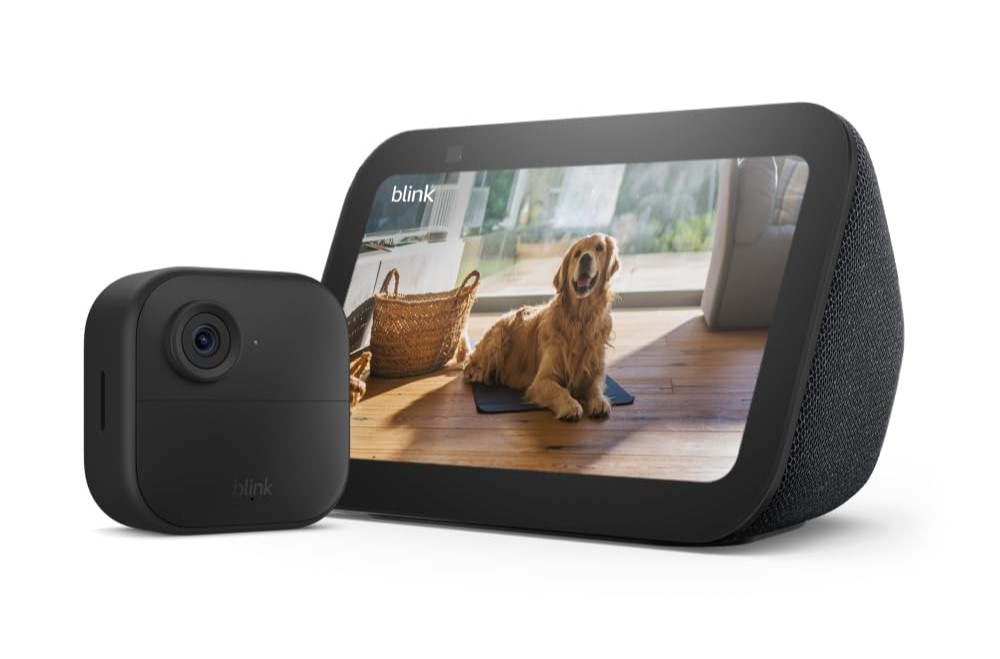
We typically see some Amazon devices, including Blink cameras, drop in price ahead of both Prime Days in July and October. This time around, Prime members have an exclusive deal available to them right now on a bundle that includes the Echo Show 5 smart display and a Blink Outdoor 4 camera system for only $60. That’s a whopping $130 off the standard price and a record low. It’s part of a larger early Prime Day sale on Blink devices, including multi-camera systems, video doorbells and more.
This bundle is one that makes a lot of sense. You’ll be able to use your Echo Show 5 to get a live view of whatever the Blink Outdoor 4 camera is capturing with a simple Alexa command.
A bundle of the Blink Outdoor 4 camera and Echo Show 5 smart display has dropped to $60, the lowest price to date. But you’ll need to be a Prime member to snag this discount.
We recommend both products individually in our guides. We believe the Blink Outdoor 4 is the best wireless security camera around. The name is a bit of a misnomer as you can easily place it inside your home too, not least because it runs on two AA batteries. You’ll only need to replace the cells every two years or so.
If you do place the camera outside, you can rest easy knowing that it’s weather resistant. Other features include night vision, motion detection and two-way audio. You will need a Blink Subscription Plan to store clips in the cloud. Otherwise, you can save footage locally with a Sync Module 2 (which is available separately) and USB flash drive.
As for the Echo Show 5, it’s one of the best smart displays with Amazon Alexa (only beaten out by its larger sibling, the Echo Show 8). It’s a compact, 5.5-inch smart display that works well as an alarm clock on your nightstand. The tap-to-snooze function comes in handy there, while there’s a sunrise alarm that gradually brightens the screen.
The Echo Show 5 does have a built-in camera, which might give you cause for concern if you want to place it by your bed. But the physical camera cover should sate any privacy concerns on that front.
Follow @EngadgetDeals on Twitter for the latest tech deals and buying advice in the lead up to October Prime Day 2024.
Technology
How IT leaders can spearhead the charge to transform education

Presented by MSI
If a primary goal of education is to prepare kids for the future, IT leaders play a more pivotal role than ever. Technology has profoundly impacted work in every industry — and it’s opened up vast new possibilities in new fields, from positions across STEM industries and AI, to esports and beyond. It’s also transformed how students engage with learning, skill development and high-level problem-solving and critical thinking.
“Exposing students to computer science and high-end technology is not only useful for the future as they inevitably use it in their careers, but it changes their relationship to school,” says Mat Holley, esports program manager at MSI. “When they’re more engaged, they have better attendance. They have better grades. They’re more prepared for college and the job market. The enthusiasm is remarkable.”
School boards are leading the charge for these initiatives, but they can’t do it on their own. They must partner with IT leaders in their district, education specialists and technology industry professionals to deliver these learning experiences, and the challenge is to ensure that these programs are cost-effective, with technology, expertise and activities that are future-proof.
How technology is transforming the learning experience
To support these initiatives, the choice of hardware and software becomes critical. Holley points to the extracurricular club in the charter school district in Chula Vista, San Diego he worked with to help develop and outfit new technology learning initiatives. Students there work on video design, broadcasting, AI and music creation using Vector GP and Raider GE series laptops from MSI, integrating graphics hardware from Nvidia and processing power from Intel. And this high-end gaming hardware and software supports what’s become the largest high school-run esports program in the U.S., the Kern High School District Esports League.
“I’ve worked with schools that are far along their journey and ready to level up their hardware, to keep pace with how the kids are working and learning, and I’ve also helped districts build the programs from the ground up, from the right hardware to student outreach,” Holley explains. “And though much of this is uncharted territory, the momentum is building, sometimes through word of mouth.”
The surprising benefits of esports
Educators are sharing knowledge, sparking interest and collaborating with their peers, working toward developing a curriculum standard and blueprint for the hardware and software specifications that can support those programs.
Though it’s initially surprised many educators and leaders that esports can have such a profound effect on kids — especially the ones who often feel excluded from other sports — the number of esports programs is growing. Not only are there tremendous educational and social development benefits for the students that participate, esports also attracts kids who have never joined an extracurricular club: the girls who have felt left out in science and math classes, the BIPOC students who deserve bigger opportunities. The clubs raise their confidence in their own abilities, and more often than not, these students go on to study computer science or some other linked technology career.
“There is no barrier to entry to be a gamer, and this goes for computer science at large,” Holley says. “You don’t even have to be a gamer to enter these clubs. More and more, esports is plugged into all the various technology clubs like design, broadcasting and journalism, and formerly disenfranchised kids are finding their calling through these clubs in an unprecedented way.”
Building the learning experience from the ground up
Of course, there continue to be challenges for school districts developing these programs, and many of them come down to major budget constraints. There are also the difficulties that come with ensuring security is solid, that new technology is integrated into existing networks, and moving the environment from on-prem to the cloud. MSI collaborates with educational institutions to ensure that they’re not only hitting the district’s hardware specs, but new hardware will be integrated seamlessly.
“As we saw more esports integrated into schools, we worked with schools to meet the specifications of their price points, their warranty needs, which are typically longer than a retail warranty,” Holley says. “We wanted to also make sure that these were machines that the students got excited to play on, that sophisticated esports titles were supported. As we started to work with more schools closely, we integrated products from our professional line to improve the student experience and give them access to even more tech areas to explore.”
Educational IT leaders rejoice: adding computer labs like these is easier than ever. As computing advances, the size of the hardware continues to shrink, making student computers lightweight and easy for IT teams to deploy. IT leaders should also look for hardware that’s easy to integrate, especially from a security point of view — however, most districts are working with legacy hardware environments.
“As you build a technology center for students, you have to consider whether existing hardware will play with the new, and whether it will move to the cloud securely,” Holley says. “But as long as we can integrate security standards like content filters, custom imaging and Autopilot deployment, it’s much easier to deploy at scale in almost any environment. We try to build directly in tandem with district-wide IT departments, so they can tell us what they need and what their road map looks like. Then from the manufacturer side, we’re able to make sure that we all play along in the years to come.”
Another major consideration is product life cycles, which are incredibly short in the consumer world. IT leaders should work with a partner that offers dedicated hardware for education, with life cycles long enough to mesh with the fairly long bidding and buying timeline for education purchases.
And of course, as cloud computing becomes the standard, it’s important to stay abreast of hardware and software changes and evolving risk scenarios. That means research, testing and working with your supplier to keep informed about the newest hardware and software advancements and when it’s time to upgrade. It also means selecting hardware that’s easily upgradable and expandable.
Making hardware choices a whole lot easier
To support technology education, MSI offers the Cubi NUC and DP21, which support Intel vPro and Windows Autopilot to simplify management, enhance security and streamline the deployment process. Thunderbolt 4 technology and power delivery offer fast connectivity and charging. They’re also easily scalable, and offer real-time data processing for AI and machine learning. Their compact size offers flexible installation and a good performance vs. footprint ratio, plus flexible configuration.
The company also offers STEM, gaming and content creation computers like the DP180, CreatorPro, Vector GP and Raider GE series laptops with dedicated graphics hardware that accelerate graphics-heavy applications, and offer easy upgradability with expandable memory and storage options to ensure longevity.
Veteran resellers and manufacturers will work with decision-makers to ensure schools get the best hardware and software their money can buy, plus keep IT teams in the loop what’s coming next, and how to make sure students have every opportunity to learn with the newest technology possible.
“We’re paving a path for these students into the future, and it’s important that we’re equipping them for everything that’s to come,” Holley says. “Gaming and other high-tech hardware has become an integral part of the plan, so IT leaders must be willing to get creative when designing technology resources and work with allies across manufacturing and reselling to push initiatives forward.”
Dig deeper: Learn more here about the technology solutions that power today’s educational experiences.
Sponsored articles are content produced by a company that is either paying for the post or has a business relationship with VentureBeat, and they’re always clearly marked. For more information, contact
Servers computers
Rack serveur 18U à montage mural – RK1820WALHM | StarTech.com
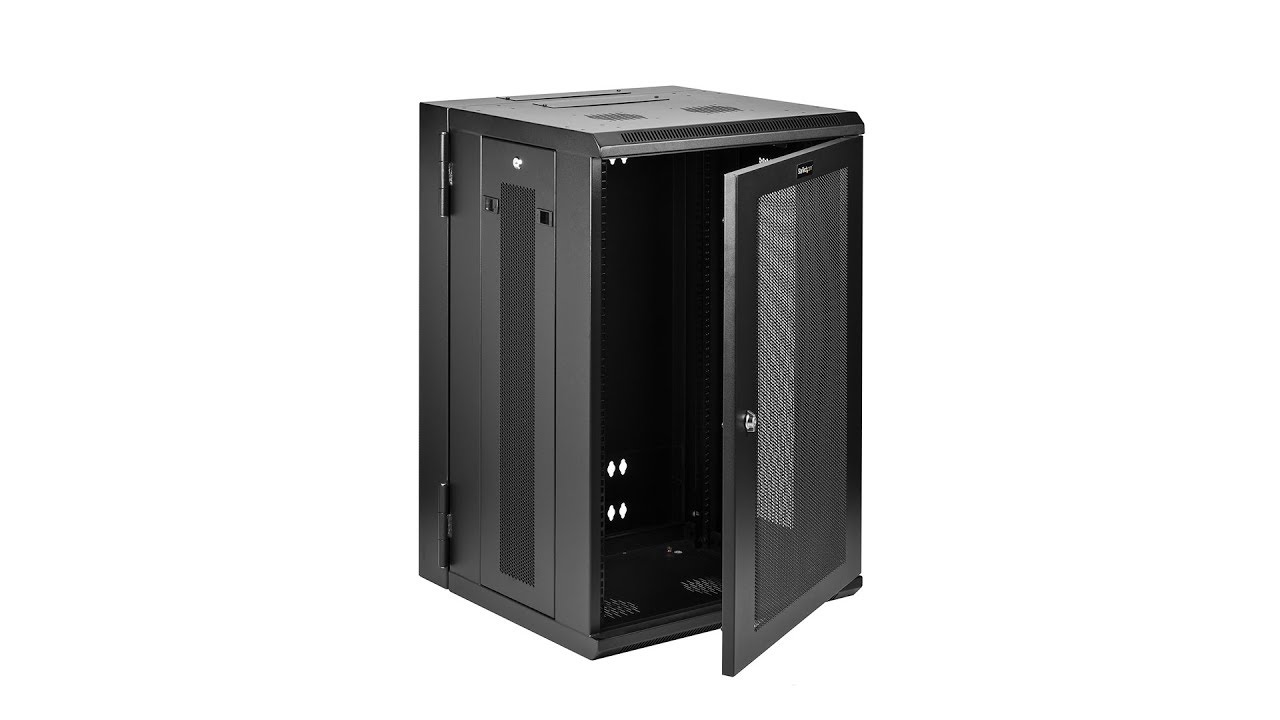
Cette armoire serveur 18U riche en fonctionnalités est idéale pour optimiser le stockage de l’équipement dans les centres de périphérie des armoires réseau et les magasins de technologie avec un espace limité, où il est nécessaire de recourir à un équipement montable. Elle est équipée de rails de montage réglables, de portes et de panneaux grillagés ainsi que d’options de refroidissement actif.
Pour plus d’information, visitez StarTech.com
source
Technology
Character.AI hires a YouTube exec as CPO, says it will raise money next year with new partners
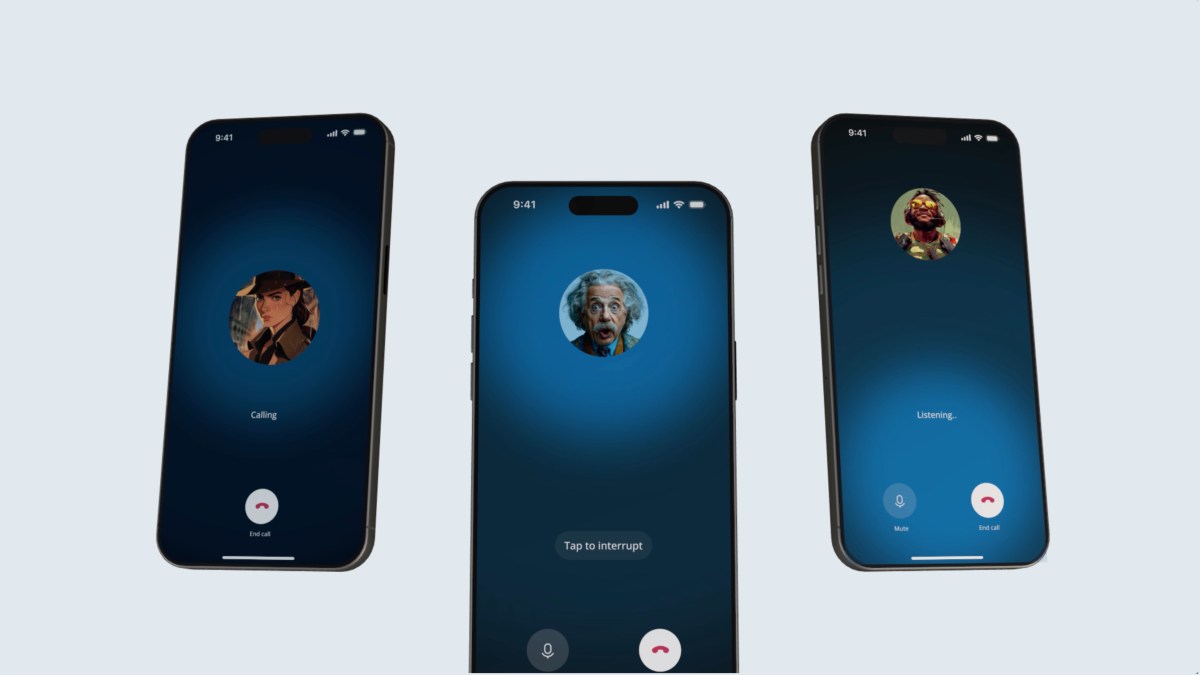
Character.AI is starting a new chapter after its $2.7 billion licensing deal with Google, which involved CEO Noam Shazeer returning to the search giant. It hired Erin Teague as a chief product officer, a YouTube exec who was the global head of sports movies and shows product management.
Teague, who has been working at Google since 2016, will join Character.AI next week. She also previously served as a technical adviser to the SVP for Search, Ads, Maps, Gemini, Assistant, shopping, and payments most recently.
“Character.AI is setting a new bar for how everyday users interact with AI, pioneering personalized and engaging AI experiences at scale,” Teague said in a statement. “I look forward to building on this one-of-a-kind platform to innovate and design new features that entertain and delight.”
In August, the company announced that Shazeer was returning to Google. Another co-founder, Daniel De Freitas, also joined Google with 30 researchers.
Post these departures, Dominic Perella, Character.AI’s interim CEO and general counsel, told TechCrunch that the company has roughly 100 employees now and will completely focus on consumer AI solutions rather than chase artificial general intelligence. As departing employees mostly focused on pre-training models, the people who are still at Character.AI are largely focused on engineering, product, and post-training and tuning models.
Teague is the first major hire for the company after the co-founders departed to Google. Character.AI said that it will still keep looking for new C-Suite executives including a CEO to replace Perella.
Character.AI’s product and roadmap
The company has bought out all investors, and it’s completely employee-owned. No VC owns shares in Character.AI. The board consists of a16z and another employee.
“I expect that sometime next year, we will go out to the market and raise funds with a new venture capital partner. The reason for this is to have that investment in the company and get additional governance, partnership, and thought leadership,” Perella said.
Character.AI, which lets users create and interact with different AI-powered characters, now has more than 20 million monthly users, which has doubled year over year. The platform now has over 100 million characters.
In June, the company launched the ability for users to call AI characters and talk with them. The startup said that users have made over 107 million calls, and 40% of its users have made at least one call.
Perella added that Character.AI characters can already talk to people through text and voice, but the company is exploring other modalities, too.
The service’s $9.99 c.ai+ subscription is one of only consistent money-generating sources. However, the company is not currently concentrating on revenue generation and is instead focusing on growth.
Character.AI said that a lot of companies have approached the startup to power their characters, and it has explored some of these partnerships, but Perella didn’t specify whether there was something concrete on the cards.
“The vision that we have is that the next big consumer platform is really going to be about personalizing your interests in a way that algorithmic feeds of the last generation didn’t,” Perella said.
Science & Environment
Fly brain sheds light on human thought process

 MRC/Nature
MRC/NatureThey can walk, hover and the males can even sing love songs to woo mates – all this with a brain that’s tinier than a pinhead.
Now for the first time scientists researching the brain of a fly have identified the position, shape and connections of every single one of its 130,000 cells and 50 million connections.
It’s the most detailed analysis of the brain of an adult animal ever produced.
One leading brain specialist independent of the new research described the breakthrough as a “huge leap” in our understanding of our own brains.
One of the research leaders said it would shed new light into “the mechanism of thought”.
Dr Gregory Jefferis, of the Medical Research Council’s Laboratory of Molecular Biology (LMB) in Cambridge told BBC News that currently we have no idea how the network of brain cells in each of our heads enables us to interact with each other and the world around us.
“What are the connections? How do the signals flow through the system that can let us process the information to recognise your face, that lets you hear my voice and turn these words into electrical signals?
“The mapping of the fly brain is really remarkable and will help us get a real grasp of how our own brains work.”
We have a million times as many brain cells, or neurons, than the fruit fly which was studied. So how can the wiring diagram of an insect brain help scientists learn how we think?
The images the scientists have produced, which have been published in the journal Nature, show a tangle of wiring that is as beautiful as it is complex.
Its shape and structure holds the key to explaining how such a tiny organ can carry out so many powerful computational tasks. Developing a computer the size of a poppy seed capable of all these tasks is way beyond the ability of modern science.
Dr Mala Murthy, another of the project’s co-leaders, from Princeton University, said the new wiring diagram, known scientifically as a connectome, would be “transformative for neuroscientists”.
“It will help researchers trying to better understand how a healthy brain works. In the future we hope that it will be possible to compare what happens when things go wrong in our brains.”
That is a view backed by Dr Lucia Prieto Godolo, a group leader in brain research at the Francis Crick Institute in London, who is independent of the research team.
“Researchers have completed the connectomes of a simple worm which has 300 wires and a maggot which has three thousand, but having a complete connectome of something with 130,000 wires is an amazing technical feat which paves the way for finding the connectomes for larger brains such as the mouse and maybe in several decades our own.”
The researchers have been able to identify separate circuits for many individual functions and show how they are connected.
The wires involved with movement for example are at the base of the brain, whereas those for processing vision are towards the side. There are many more neurons involved in the latter because seeing requires much more computational power.
While scientists already knew about the separate circuits they did not know how they were connected together.
Why are flies so difficult to swat?
Other researchers are already using the circuit diagrams, for example to work out why flies are so difficult to swat.
The vision circuits detect which direction your rolled up newspaper is coming from, and they pass on the signal to the fly’s legs.
But crucially, they send a stronger jumping signal to the legs facing away from the object of their imminent demise. So you could say they jump away without even having to think – literally faster than the speed of thought.
This finding may explain why we lumbering humans seldom squash flies.
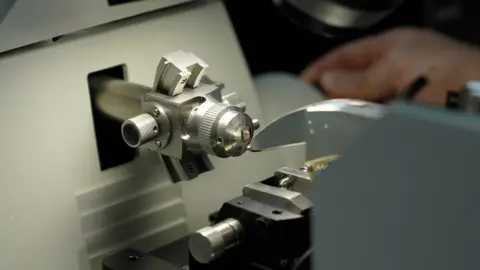 Gwyndaf Hughes/BBC News
Gwyndaf Hughes/BBC NewsThe wiring diagram was made by slicing up a fly brain using what is essentially a microscopic cheese grater, photographing each of the 7,000 slices and digitally putting them altogether. Then the Princeton team applied artificial intelligence to extract the shapes and connections of all the neurons. But the AI wasn’t perfect – the researchers still had to fix over three million mistakes by hand.
This in itself was a technical tour de force, but the job was only half done. The map on its own was meaningless unless there was a description of what each wire was supposed to do, according to Dr Philipp Schlegel, who is also from the Medical Research Council’s Laboratory of Molecular Biology.
“This data is a bit like Google Maps but for brains: the raw wiring diagram between neurons is like knowing which structures correspond to streets and buildings.
“Describing the neurons is like adding the names for streets and towns, business opening times, phone numbers, reviews, etc. to the map. You need both for it to be really useful.”
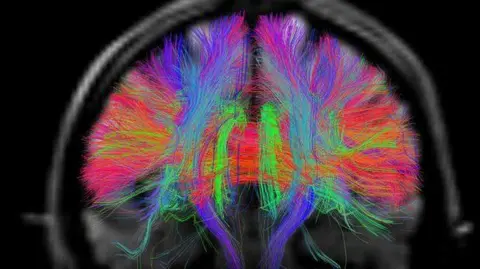 BBC News
BBC NewsThe fly connectome is available to any scientist that wants to use it to guide their research. Dr Schlegel believes that the world of neuroscience will see “an avalanche of discoveries in the next couple of years” thanks to this new map.
A human brain is so much larger than the fly’s, and we don’t yet have the technology to capture all the information about its wiring.
But the researchers believe that perhaps in 30 years it may be possible to have a human connectome. The fly brain, they say, is a start of a new, deeper understanding of how our own minds work.
The research has been conducted by a large international collaboration of scientists, called the FlyWire Consortium.
-

 Womens Workouts1 week ago
Womens Workouts1 week ago3 Day Full Body Women’s Dumbbell Only Workout
-

 Technology2 weeks ago
Technology2 weeks agoWould-be reality TV contestants ‘not looking real’
-

 Science & Environment2 weeks ago
Science & Environment2 weeks ago‘Running of the bulls’ festival crowds move like charged particles
-

 Science & Environment2 weeks ago
Science & Environment2 weeks agoHyperelastic gel is one of the stretchiest materials known to science
-

 Science & Environment2 weeks ago
Science & Environment2 weeks agoMaxwell’s demon charges quantum batteries inside of a quantum computer
-

 Science & Environment2 weeks ago
Science & Environment2 weeks agoHow to unsnarl a tangle of threads, according to physics
-

 Science & Environment2 weeks ago
Science & Environment2 weeks agoHow to wrap your mind around the real multiverse
-

 News1 week ago
News1 week agoOur millionaire neighbour blocks us from using public footpath & screams at us in street.. it’s like living in a WARZONE – WordupNews
-

 Science & Environment2 weeks ago
Science & Environment2 weeks agoSunlight-trapping device can generate temperatures over 1000°C
-

 Science & Environment2 weeks ago
Science & Environment2 weeks agoLiquid crystals could improve quantum communication devices
-

 Science & Environment2 weeks ago
Science & Environment2 weeks agoITER: Is the world’s biggest fusion experiment dead after new delay to 2035?
-

 Science & Environment2 weeks ago
Science & Environment2 weeks agoPhysicists are grappling with their own reproducibility crisis
-

 Science & Environment2 weeks ago
Science & Environment2 weeks agoQuantum ‘supersolid’ matter stirred using magnets
-

 Science & Environment2 weeks ago
Science & Environment2 weeks agoWhy this is a golden age for life to thrive across the universe
-

 News2 weeks ago
News2 weeks agoYou’re a Hypocrite, And So Am I
-

 Sport2 weeks ago
Sport2 weeks agoJoshua vs Dubois: Chris Eubank Jr says ‘AJ’ could beat Tyson Fury and any other heavyweight in the world
-

 Science & Environment2 weeks ago
Science & Environment2 weeks agoQuantum forces used to automatically assemble tiny device
-

 Science & Environment2 weeks ago
Science & Environment2 weeks agoNuclear fusion experiment overcomes two key operating hurdles
-

 Science & Environment2 weeks ago
Science & Environment2 weeks agoCaroline Ellison aims to duck prison sentence for role in FTX collapse
-

 Science & Environment2 weeks ago
Science & Environment2 weeks agoTime travel sci-fi novel is a rip-roaringly good thought experiment
-

 Science & Environment2 weeks ago
Science & Environment2 weeks agoLaser helps turn an electron into a coil of mass and charge
-

 Science & Environment2 weeks ago
Science & Environment2 weeks agoNerve fibres in the brain could generate quantum entanglement
-

 News2 weeks ago
News2 weeks agoIsrael strikes Lebanese targets as Hizbollah chief warns of ‘red lines’ crossed
-

 CryptoCurrency2 weeks ago
CryptoCurrency2 weeks agoCardano founder to meet Argentina president Javier Milei
-

 Science & Environment1 week ago
Science & Environment1 week agoMeet the world's first female male model | 7.30
-

 Womens Workouts2 weeks ago
Womens Workouts2 weeks agoBest Exercises if You Want to Build a Great Physique
-

 CryptoCurrency2 weeks ago
CryptoCurrency2 weeks agoEthereum is a 'contrarian bet' into 2025, says Bitwise exec
-

 News2 weeks ago
News2 weeks ago▶️ Media Bias: How They Spin Attack on Hezbollah and Ignore the Reality
-

 Science & Environment2 weeks ago
Science & Environment2 weeks agoA slight curve helps rocks make the biggest splash
-

 Science & Environment2 weeks ago
Science & Environment2 weeks agoWhy we need to invoke philosophy to judge bizarre concepts in science
-

 CryptoCurrency2 weeks ago
CryptoCurrency2 weeks agoBitcoin miners steamrolled after electricity thefts, exchange ‘closure’ scam: Asia Express
-

 CryptoCurrency2 weeks ago
CryptoCurrency2 weeks agoDZ Bank partners with Boerse Stuttgart for crypto trading
-

 CryptoCurrency2 weeks ago
CryptoCurrency2 weeks agoBitcoin bulls target $64K BTC price hurdle as US stocks eye new record
-

 Womens Workouts2 weeks ago
Womens Workouts2 weeks agoEverything a Beginner Needs to Know About Squatting
-

 News1 week ago
News1 week agoFour dead & 18 injured in horror mass shooting with victims ‘caught in crossfire’ as cops hunt multiple gunmen
-

 Womens Workouts1 week ago
Womens Workouts1 week ago3 Day Full Body Toning Workout for Women
-

 Travel1 week ago
Travel1 week agoDelta signs codeshare agreement with SAS
-

 Politics7 days ago
Politics7 days agoHope, finally? Keir Starmer’s first conference in power – podcast | News
-

 Sport2 weeks ago
Sport2 weeks agoUFC Edmonton fight card revealed, including Brandon Moreno vs. Amir Albazi headliner
-

 Technology2 weeks ago
Technology2 weeks agoiPhone 15 Pro Max Camera Review: Depth and Reach
-

 News2 weeks ago
News2 weeks agoBrian Tyree Henry on voicing young Megatron, his love for villain roles
-

 Science & Environment2 weeks ago
Science & Environment2 weeks agoQuantum time travel: The experiment to ‘send a particle into the past’
-

 CryptoCurrency2 weeks ago
CryptoCurrency2 weeks agoDorsey’s ‘marketplace of algorithms’ could fix social media… so why hasn’t it?
-

 CryptoCurrency2 weeks ago
CryptoCurrency2 weeks agoRedStone integrates first oracle price feeds on TON blockchain
-

 CryptoCurrency2 weeks ago
CryptoCurrency2 weeks agoLow users, sex predators kill Korean metaverses, 3AC sues Terra: Asia Express
-

 CryptoCurrency2 weeks ago
CryptoCurrency2 weeks agoBlockdaemon mulls 2026 IPO: Report
-

 CryptoCurrency2 weeks ago
CryptoCurrency2 weeks agoCoinbase’s cbBTC surges to third-largest wrapped BTC token in just one week
-

 News1 week ago
News1 week agoWhy Is Everyone Excited About These Smart Insoles?
-

 Science & Environment2 weeks ago
Science & Environment2 weeks agoA new kind of experiment at the Large Hadron Collider could unravel quantum reality
-

 Science & Environment2 weeks ago
Science & Environment2 weeks agoHow one theory ties together everything we know about the universe
-

 Health & fitness2 weeks ago
Health & fitness2 weeks agoThe maps that could hold the secret to curing cancer
-
News2 weeks ago
the pick of new debut fiction
-

 Science & Environment2 weeks ago
Science & Environment2 weeks agoBeing in two places at once could make a quantum battery charge faster
-

 CryptoCurrency2 weeks ago
CryptoCurrency2 weeks agoCrypto scammers orchestrate massive hack on X but barely made $8K
-

 Science & Environment2 weeks ago
Science & Environment2 weeks agoTiny magnet could help measure gravity on the quantum scale
-

 Science & Environment2 weeks ago
Science & Environment2 weeks agoFuture of fusion: How the UK’s JET reactor paved the way for ITER
-

 Science & Environment2 weeks ago
Science & Environment2 weeks agoHow do you recycle a nuclear fusion reactor? We’re about to find out
-

 CryptoCurrency2 weeks ago
CryptoCurrency2 weeks agoTelegram bot Banana Gun’s users drained of over $1.9M
-

 CryptoCurrency2 weeks ago
CryptoCurrency2 weeks agoVonMises bought 60 CryptoPunks in a month before the price spiked: NFT Collector
-

 CryptoCurrency2 weeks ago
CryptoCurrency2 weeks agoSEC asks court for four months to produce documents for Coinbase
-

 CryptoCurrency2 weeks ago
CryptoCurrency2 weeks ago‘No matter how bad it gets, there’s a lot going on with NFTs’: 24 Hours of Art, NFT Creator
-
Business2 weeks ago
How Labour donor’s largesse tarnished government’s squeaky clean image
-

 News2 weeks ago
News2 weeks agoBrian Tyree Henry on voicing young Megatron, his love for villain roles
-

 Womens Workouts2 weeks ago
Womens Workouts2 weeks agoHow Heat Affects Your Body During Exercise
-

 Womens Workouts2 weeks ago
Womens Workouts2 weeks agoKeep Your Goals on Track This Season
-

 Science & Environment1 week ago
Science & Environment1 week agoX-rays reveal half-billion-year-old insect ancestor
-

 News2 weeks ago
News2 weeks agoChurch same-sex split affecting bishop appointments
-

 Technology2 weeks ago
Technology2 weeks agoFivetran targets data security by adding Hybrid Deployment
-

 Politics2 weeks ago
Politics2 weeks agoLabour MP urges UK government to nationalise Grangemouth refinery
-

 CryptoCurrency2 weeks ago
CryptoCurrency2 weeks ago$12.1M fraud suspect with ‘new face’ arrested, crypto scam boiler rooms busted: Asia Express
-

 Science & Environment2 weeks ago
Science & Environment2 weeks agoUK spurns European invitation to join ITER nuclear fusion project
-

 CryptoCurrency2 weeks ago
CryptoCurrency2 weeks agoDecentraland X account hacked, phishing scam targets MANA airdrop
-

 CryptoCurrency2 weeks ago
CryptoCurrency2 weeks agoCertiK Ventures discloses $45M investment plan to boost Web3
-

 CryptoCurrency2 weeks ago
CryptoCurrency2 weeks agoBeat crypto airdrop bots, Illuvium’s new features coming, PGA Tour Rise: Web3 Gamer
-

 CryptoCurrency2 weeks ago
CryptoCurrency2 weeks ago‘Silly’ to shade Ethereum, the ‘Microsoft of blockchains’ — Bitwise exec
-

 CryptoCurrency2 weeks ago
CryptoCurrency2 weeks agoVitalik tells Ethereum L2s ‘Stage 1 or GTFO’ — Who makes the cut?
-

 CryptoCurrency2 weeks ago
CryptoCurrency2 weeks agoEthereum falls to new 42-month low vs. Bitcoin — Bottom or more pain ahead?
-
Business2 weeks ago
Thames Water seeks extension on debt terms to avoid renationalisation
-
Politics2 weeks ago
‘Appalling’ rows over Sue Gray must stop, senior ministers say | Sue Gray
-

 News2 weeks ago
News2 weeks agoBrian Tyree Henry on his love for playing villains ahead of “Transformers One” release
-
Politics2 weeks ago
UK consumer confidence falls sharply amid fears of ‘painful’ budget | Economics
-

 Womens Workouts2 weeks ago
Womens Workouts2 weeks agoWhich Squat Load Position is Right For You?
-

 Science & Environment1 week ago
Science & Environment1 week agoCNN TÜRK – 🔴 Canlı Yayın ᴴᴰ – Canlı TV izle
-

 Technology1 week ago
Technology1 week agoRobo-tuna reveals how foldable fins help the speedy fish manoeuvre
-

 News6 days ago
News6 days agoUS Newspapers Diluting Democratic Discourse with Political Bias
-

 Technology2 weeks ago
Technology2 weeks agoIs carbon capture an efficient way to tackle CO2?
-

 Politics2 weeks ago
Politics2 weeks agoTrump says he will meet with Indian Prime Minister Narendra Modi next week
-

 Science & Environment2 weeks ago
Science & Environment2 weeks agoSingle atoms captured morphing into quantum waves in startling image
-

 Technology2 weeks ago
Technology2 weeks agoCan technology fix the ‘broken’ concert ticketing system?
-

 Fashion Models2 weeks ago
Fashion Models2 weeks agoMixte
-

 Science & Environment2 weeks ago
Science & Environment2 weeks agoHow Peter Higgs revealed the forces that hold the universe together
-

 Health & fitness2 weeks ago
Health & fitness2 weeks agoThe secret to a six pack – and how to keep your washboard abs in 2022
-

 CryptoCurrency2 weeks ago
CryptoCurrency2 weeks ago2 auditors miss $27M Penpie flaw, Pythia’s ‘claim rewards’ bug: Crypto-Sec
-

 CryptoCurrency2 weeks ago
CryptoCurrency2 weeks agoJourneys: Robby Yung on Animoca’s Web3 investments, TON and the Mocaverse
-

 CryptoCurrency2 weeks ago
CryptoCurrency2 weeks agoLouisiana takes first crypto payment over Bitcoin Lightning
-

 CryptoCurrency2 weeks ago
CryptoCurrency2 weeks ago‘Everything feels like it’s going to shit’: Peter McCormack reveals new podcast
-

 Science & Environment2 weeks ago
Science & Environment2 weeks agoA tale of two mysteries: ghostly neutrinos and the proton decay puzzle
-

 CryptoCurrency2 weeks ago
CryptoCurrency2 weeks agoSEC sues ‘fake’ crypto exchanges in first action on pig butchering scams
-

 CryptoCurrency2 weeks ago
CryptoCurrency2 weeks agoBitcoin price hits $62.6K as Fed 'crisis' move sparks US stocks warning
-

 CryptoCurrency2 weeks ago
CryptoCurrency2 weeks agoCZ and Binance face new lawsuit, RFK Jr suspends campaign, and more: Hodler’s Digest Aug. 18 – 24

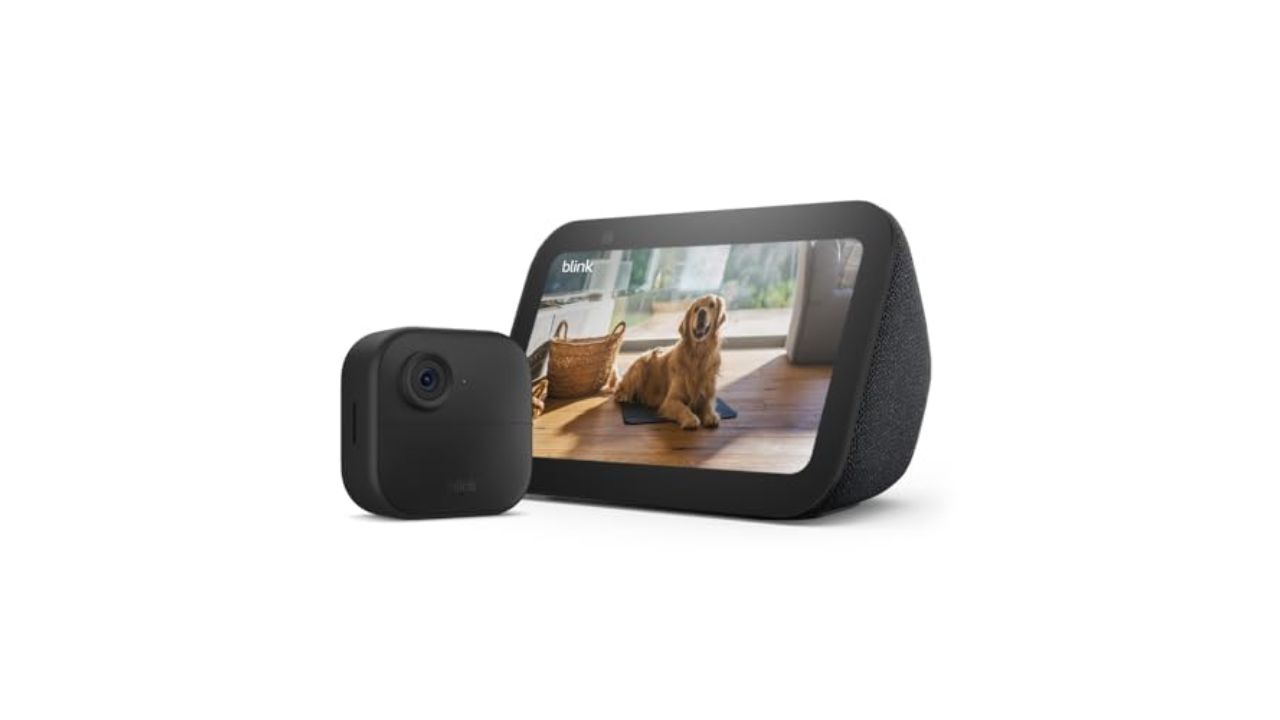

You must be logged in to post a comment Login